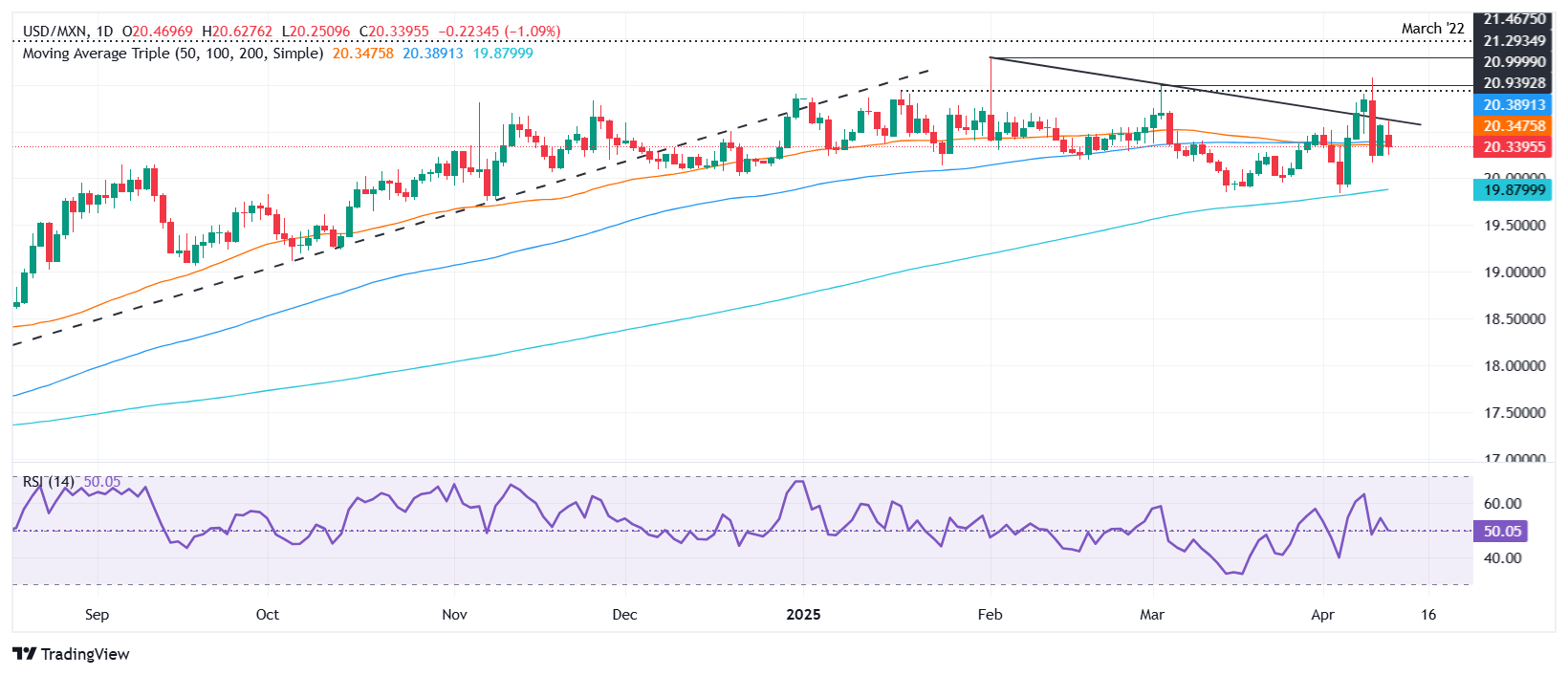Mexican Peso ends week strong as USD plunges on China tariff retaliation
- Mexican Peso gains as China retaliates with 125% tariffs, sending the US Dollar Index below 100 for the first time since 2021.
- Banxico minutes show unanimous concern over decelerating growth; rate cut likely at next meeting.
- US data mixed: PPI cools but remains elevated; sentiment slumps and inflation expectations jump.
The Mexican Peso ends the week on a higher note as the Greenback weakens across the board. The China-US trade war escalated, with China retaliating against US President Trump’s latest tariffs announcement. The USD/MXN trades at 20.27, down 0.72%.
The financial markets' narrative remains around tariffs. China’s answer to US 145% was known early in the North American session, with Beijing applying 125% duties on US products. After the headline, the buck plunged sharply, as revealed by the US Dollar Index (DXY), which tracks its performance against a basket of six other currencies. The DXY reached an over 30-month low of 99.01. As of writing, the DXY is at 99.87, down more than 1%.
Mexico’s Industrial Production improved in February, revealed the Instituto Nacional de Estadística Geografía e Informática (INEGI). Meanwhile, Banco de Mexico (Banxico)'s last meeting minutes revealed that all its members said the economy is decelerating and the disinflation process has evolved.
Regarding tariffs, Mexican products outside of the USMCA trade agreement remain subject to 25% duties, despite the 90-day pause on other countries, revealed a White House official.
Data from the United States (US) revealed that the Producer Price Index (PPI) dipped compared to February’s data. The Core PPI cooled as well but remained above the 3% threshold.
Other data showed that the Consumer Sentiment deteriorated sharply and inflation expectations rose.
Although the USD/MXN is dropping, further upside is seen. Banxico is expected to lower rates at the upcoming meeting. In contrast, the Fed would likely hold rates unchanged at the May meeting, with investors seeing the first cut in July.
Daily digest market movers: Mexican Peso unfazed by high US yields, risk aversion
INEGI revealed that Mexico's Industrial Production in February rose by 2.5% MoM, up from a -0.6% contraction in January. In the twelve months to February, production improved from a -2.9% contraction to -1.3% YoY.
Banxico Governor Victoria Rodriguez Ceja appeared before the Senate. She said the Government Board is still unsatisfied with the inflation rate, which stood at 3.8% YoY in March, though far from the 3% target. She added that the disinflation process and the economic slowdown justify Banxico’s dovish approach and hinted that the central bank might continue easing policy.
US Consumer Sentiment fell sharply in April, with the University of Michigan Index dropping from 57.0 to 50.8. Inflation expectations jumped, with the 1-year outlook rising from 5% to 6.7% and the 5-year from 4.1% to 4.4%.
US March PPI eased to 2.7% YoY, below the 3.3% forecast and down from 3.2%, signaling softer input costs.
Core PPI held firm at 3.3% YoY, down from 3.5%, yet still above the 3% threshold.
USD/MXN technical outlook: Mexican Peso appreciates as USD/MXN falls beneath 20.50
The USD/MXN uptrend remains in play, though sellers stepped in, dragging the spot price below the 20.50 figure. Towards the end of the session, bears drove the exchange rate below the confluence of the 50-day and 100-day Simple Moving Averages (SMAs) near 20.33/36, which, if surpassed, clears the floor to test 20.00.
Conversely, if USD/MXN climbs past the April 9 daily peak of 21.07, the pair could be poised to challenge the year-to-date (YTD) high of 21.28.

Mexican Peso FAQs
The Mexican Peso (MXN) is the most traded currency among its Latin American peers. Its value is broadly determined by the performance of the Mexican economy, the country’s central bank’s policy, the amount of foreign investment in the country and even the levels of remittances sent by Mexicans who live abroad, particularly in the United States. Geopolitical trends can also move MXN: for example, the process of nearshoring – or the decision by some firms to relocate manufacturing capacity and supply chains closer to their home countries – is also seen as a catalyst for the Mexican currency as the country is considered a key manufacturing hub in the American continent. Another catalyst for MXN is Oil prices as Mexico is a key exporter of the commodity.
The main objective of Mexico’s central bank, also known as Banxico, is to maintain inflation at low and stable levels (at or close to its target of 3%, the midpoint in a tolerance band of between 2% and 4%). To this end, the bank sets an appropriate level of interest rates. When inflation is too high, Banxico will attempt to tame it by raising interest rates, making it more expensive for households and businesses to borrow money, thus cooling demand and the overall economy. Higher interest rates are generally positive for the Mexican Peso (MXN) as they lead to higher yields, making the country a more attractive place for investors. On the contrary, lower interest rates tend to weaken MXN.
Macroeconomic data releases are key to assess the state of the economy and can have an impact on the Mexican Peso (MXN) valuation. A strong Mexican economy, based on high economic growth, low unemployment and high confidence is good for MXN. Not only does it attract more foreign investment but it may encourage the Bank of Mexico (Banxico) to increase interest rates, particularly if this strength comes together with elevated inflation. However, if economic data is weak, MXN is likely to depreciate.
As an emerging-market currency, the Mexican Peso (MXN) tends to strive during risk-on periods, or when investors perceive that broader market risks are low and thus are eager to engage with investments that carry a higher risk. Conversely, MXN tends to weaken at times of market turbulence or economic uncertainty as investors tend to sell higher-risk assets and flee to the more-stable safe havens.

